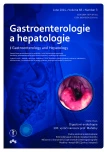Bezbolestná kolonoskopie
Autoři:
S. Cadoni
Působiště autorů:
Digestive Endoscopy Unit, S. Barbara Hospital, Iglesias (CI), Italy
Vyšlo v časopise:
Gastroent Hepatol 2014; 68(3): 192-193
Kategorie:
Digestivní endoskopie: komentář
Souhrn
Autor deklaruje, že v souvislosti s předmětem studie nemá žádné komerční zájmy.
Redakční rada potvrzuje, že rukopis práce splnil ICMJE kritéria pro publikace zasílané do biomedicínských časopisů.
Zdroje
1. Shah SG, Brooker JC, Thapar C et al. Patient pain during colonoscopy: an analysis using real-time magnetic endoscope imaging. Endoscopy 2002; 34(6): 435–440.
2. Takahashi Y, Tanaka H, Kinjo M et al. Sedation-free colonoscopy. Dis Colon Rectum 2005; 48(4): 855–859.
3. Sharma VK, Nguyen CC, Crowell MD et al. A national study of cardiopulmonary unplanned events after GI endoscopy. Gastrointest Endosc 2007; 66(1): 27–34.
4. Leung FW, Aljebreen AM, Brocchi E et al. Sedation-risk-free colonoscopy for minimizing the burden of colorectal cancer screening. World J Gastrointest Endosc 2010; 2(3): 81–89. doi: 10.4253/wjge.v2.i3.81.
5. Al-Awabdy B, Wilcox CM. Use of anesthesia on the rise in gastrointestinal endoscopy. World J Gastrointest Endosc 2013; 5(1): 1–5. doi: 10.4253/wjge.v5.i1.1.
6. Park DI, Kim HJ, Park JH et al. Factors affecting abdominal pain during colonoscopy. Eur J Gastroenterol Hepatol 2007; 19(8): 695–699.
7. Eckardt AJ, Swales C, Bhattacharya K et al. Open access colonoscopy in the training setting: which factors affect patient satisfaction and pain? Endoscopy 2008; 40(2): 98–105. doi: 10.1055/s-2007-995469.
8. Paggi S, Radaelli F, Amato A et al. Unsedated colonoscopy: an option for some but not for all. Gastrointest Endosc 2012; 75(2): 392–398. doi: 10.1016/j.gie.2011.09.015.
9. Petrini JL, Egan JV, Hahn WV. Unsedated colonoscopy: patient characteristics and satisfaction in a community-based endoscopy unit. Gastrointest Endosc 2009; 69(3 Pt 1): 567–572. doi: 10.1016//j.gie.2008.10.027.
10. Leung J, Mann S, Siao-Salera R et al. A randomized, controlled trial to confirm the beneficial effects of the water method on U.S. veterans undergoing colonoscopy with the option of on-demand sedation. Gastrointest Endosc 2011; 73(1): 103–110. doi: 10.1016/j.gie.2010.09.020.
11. Leung JW, Mann S, Leung FW. Option for screening colonoscopy without sedation: a pilot study in United States veterans. Alimen Pharmacol Ther 2007; 26(4): 627–631.
12. Leung FW, Aharonian HS, Leung JW et al. Impact of a novel water method on scheduled unsedated colonoscopy in U.S. veterans. Gastrointest Endosc 2009; 69(3 Pt 1): 546–550. doi: 10.1016//j.gie.2008.08.014.
13. Leung FW, Harker JO, Jackson G et al. A proof-of-principle, prospective, randomized controlled trial demonstrating improved outcomes in scheduled unsedated colonoscopy by the water method. Gastrointest Endosc 2010; 72(4): 693–700. doi: 10.1016/j.gie.2010.05.020.
14. Leung JW, Mann S, Siao-Salera R et al. The established and time-tested water exchange method in scheduled unsedated colonoscopy significantly enhanced patient-centered outcomes without prolonging procedural times – A randomized controlled trial. J Interv Gastroenterol 2013; 3(1): 7–11.
15. Park CH, Lee WS, Joo YE et al. Sedation-free colonoscopy using an upper endoscope is tolerable and effective in patients with low body mass index: a prospective randomized study. Am J Gastroenterol 2006; 101(11): 2504–2510.
16. Garborg KK, Loberg M, Matre J et al. Reduced pain during screening colonoscopy with an ultrathin colonoscope: a randomized controlled trial. Endoscopy 2012; 44(8): 740–746. doi: 10.1055//s-0032-1309755.
17. Brooker JC, Saunders BP, Shah SG et al. A new variable stiffness colonoscope makes colonoscopy easier: a randomised controlled trial. Gut 2000; 46(6): 801–805.
18. Wu H, Hu B. The role of carbon dioxide insufflation in colonoscopy: a systematic review and meta-analysis. Endoscopy 2012; 44(2): 128–136. doi: 10.1055/s-0031-1291487.
19. Hoff G, Bretthauer M, Dahler S et al. Improvement in caecal intubation rate and pain reduction by using 3-dimensional magnetic imaging for unsedated colonoscopy: a randomized trial of patients referred for colonoscopy. Scand J Gastroenterol 2007; 42(7): 885–889.
20. Leung FW. Water-aided colonoscopy. Gastroenterol Clin North Am 2013; 42(3): 507–519. doi: 10.1016/j.gtc.2013.05.006.
21. Maple JT, Banerjee S, Barth BA et al. Methods of luminal distention for colonoscopy. Gastrointest Endosc 2013; 77(4): 519–525. doi: 10.1016/j.gie.2012.09.025.
22. Rabenstein T, Radaelli F, Zolk O. Warm water infusion colonoscopy: a review and meta-analysis. Endoscopy 2012; 44(10): 940–951. doi: 10.1055/s-0032-1310157.
23. Leung FW, Amato A, Ell C et al. Water-aided colonoscopy: a systematic review. Gastrointest Endosc 2012; 76(3): 657–666. doi: 10.1016/j.gie.2012.04.467.
24. Falt P, Liberda M, Smajstrla V et al. Combination of water immersion and carbon dioxide insufflation for minimal sedation colonoscopy: a prospective, randomized, single-center trial. Eur J Gastroenterol Hepatol 2012; 24(8): 971– 977. doi: 10.1097//MEG.0b013e3283543f16.
25. Amato A, Radaelli F, Paggi S et al. Carbon dioxide insufflation or warm-water infusion versus standard air insufflation for unsedated colonoscopy: a randomized controlled trial. Dis Colon Rectum 2013; 56(4): 511–518. doi: 10.1097//DCR.0b013e318279addd.
26. Cadoni S, Gallittu P, Sanna S et al. A two-center randomized controlled trial of water-aided colonoscopy versus air insufflation colonoscopy. Endoscopy 2014; 46(3): 212–218. doi: 10.1055/s-0033-1353604.
27. Hsieh YH, Koo M, Leung FW. A patient-blinded randomized, controlled trial comparing air insufflation, water immersion and water exchange during minimally sedated colonoscopy. Am J Gastroenterol 2014. [in press]. doi: 10.1038/ajg.2014.126.
28. Cadoni S, Sanna S, Gallittu P et al. Impact on maximum insertion pain during diagnostic and screening colonoscopy with on demand sedation: a two center randomized controlled trial of air insufflation, water immersion and water exchange. Gastrointest Endosc 2014; 79 (5 Suppl): AB126–AB127.
29. Falt P. Water-aided colonoscopy. Gastroent Hepatol 2014; 68(3): 194–201.
Štítky
Dětská gastroenterologie Gastroenterologie a hepatologie Chirurgie všeobecnáČlánek vyšel v časopise
Gastroenterologie a hepatologie

2014 Číslo 3
- Metamizol jako analgetikum první volby: kdy, pro koho, jak a proč?
- Specifika v komunikaci s pacienty s ránou – laická doporučení
- Horní limit denní dávky vitaminu D: Jaké množství je ještě bezpečné?
- Léčba akutní pooperační bolesti z pohledu ortopeda
Nejčtenější v tomto čísle
- Rifaximin v léčbě gastrointestinálních onemocnění
- Citrafleet® – jednoduchá a efektivní příprava tlustého střeva před vyšetřením
- Akútne krvácanie do horného gastrointestinálneho traktu – zriedkavá manifestácia adenokarcinómu pankreasu
- Neobvyklá komplikace ERCP
